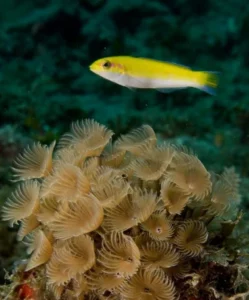Discover how the sex change occurs in fish
It is not difficult to find fish that change sex with adulthood , around 500 species are known to do so. Some well-known examples are groupers, clown fish , and the present case, Thalasoma bifasciatum , the blue- headed wrasse or as it is known in English bluehead wrasse .
Thalasoma bifasciatum is a wrasse that inhabits the coral reefs of the Caribbean Sea in groups where a blue male protects a harem of yellow females. When the male is removed, the largest female becomes a male in just 10 days . Its behavior changes in a matter of minutes and its color to blue in a matter of hours. Your ovary becomes a testicle and after 10 days it is capable of producing sperm.
This sex change has the peculiarity that it is very fast and, in addition, it is triggered by a visual signal. This rapidity in the change of sex is surprising since it is also due to the signals that activate it.
The sex change of fish: we already know how one of them works
Using the latest genetic approaches, high-throughput RNA sequencing, and epigenetic analyzes, the researchers discovered when and how specific genes are turned off and on in the brain and gonad so that a sex change can occur.

The data suggest that the environmental stimulus is exerted through the stress axis and that repression of the aromatase gene (which encodes the enzyme that converts androgens to estrogens) triggers a cascade breakdown of feminizing gene expression through the cortisol and identifies a marked neo-functionalization of the sex-specific gene.
To understand it more simply, the stress generated by the lack of the male (visual signal: stop seeing a blue fish) is the cause that triggers a series of signals and produces cortisol (the stress hormone). This signal causes the enzyme that converts androgens (male hormones) to estrogens (female hormones) to stop expressing itself, and thus only male hormones are expressed and the female fish changes sex.
This is very important, as it implies that a developmental process is reversed to completely alter the structures of the organs due to epigenetic reprogramming.
[box type = »info» align = »» class = »» width = »»] Epigenetics is called the process of controlling the expression of genes without modifying the DNA, with changes that are heritable.
This control can be carried out by a variety of factors such as nutrition, the presence or absence of predators, of individuals of the same species, among other factors. [/ Box]
The study is important to understand how genes are turned on and off during development in all animals (including humans) and how the environment can influence this process.
Another animal in which this sex change has been studied is the dragon lizard. In this case, the sex change is triggered by the change in temperature.



